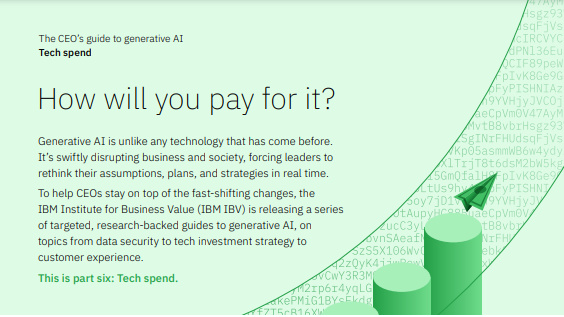The end of the slowdown? Global cloud spending is set to surge by 20% in 2024 as enterprises ramp up migration plans and capitalize on generative AI
Global cloud spending will surge in the year ahead, analysis shows, marking a shift away from a period of ruthless optimization


Global cloud spending is expected to increase by 20% in 2024, according to new research from Canalys.
Analysis from the consultancy points to an optimistic outlook in the industry for the year ahead off the back of a 19% year on year (YoY) growth rate recorded in Q4 of 2023, with total spending reaching $78.1 billion.
Canalys said this marked an increase of $12.3 billion, with the total cumulative yearly increase of 2023 amounting to $290.4 billion - up from $247.1 billion in 2022.
A key factor in the increase, according to Canalys, is that the “influence of enterprise IT optimization” is fading. As a result of this, more customers are building on their commitments with hyperscalers in anticipation of heightened consumption requirements over the coming year.
Cloud migration projects are also picking up speed in tandem with an increasing surge in the adoption of artificial intelligence (AI), Canalys said.
Hyperscalers in particular are focusing on generative AI investment with an expectation that it will enhance cloud computing capabilities.
Cloud spending shows the ‘slowdown’ might be over
The latest analysis from Canalys points toward a more optimistic outlook in the year ahead for both enterprises and providers alike.
Sign up today and you will receive a free copy of our Future Focus 2025 report - the leading guidance on AI, cybersecurity and other IT challenges as per 700+ senior executives
In January 2023, industry analysts warned of a potentially disastrous “cloud slowdown” as enterprises cut spending on cloud services due to tightening budgets and increased economic uncertainty.
RELATED WHITEPAPER
But research from Gartner in late 2023 found that while budgets were still tight, many organizations viewed proactive investment in the cloud as a means of weathering troubling economic conditions and preparing for future success.
The consultancy predicted a similar spending boost of 20% in 2024 and beyond.
Sid Nag, VP analyst at Gartner, told ITPro at the time that cloud has become “essentially indispensable”, adding that many enterprises have come to accept that neglecting investment in this business domain could create longer-term challenges and impact their ability to compete.
How the hyperscalers are performing
Amazon Web Services (AWS), Google Cloud Platform (GCP), and Microsoft Azure all saw varying degrees of growth due to cloud spending increases, according to Canalys.
Though accounting for the smallest amount of growth in 2023, AWS still leads the pack in cloud infrastructure, dominating the market and accounting for 31% of total market spend.
After a few quarters of slowing growth, AWS also saw a small upward trajectory in 2023 with a revenue increase of 13%. Its future committed spending by customers now stands at $155.7 billion, a YoY increase of about $45 billion.
“AWS has been slower than its key competitors to make AI advances, which may explain why its growth is not accelerating as rapidly as that of Azure and GCP,” said Yi Zhang, analyst at Canalys.
Microsoft Azure is the second in line in terms of size, now claiming an enhanced market share of 26% as of Q4 2023. This compares to 23% in Q4 2022.
This can be attributed in part to an increased level of AI adoption, according to Canalys, as Azure has been expanded to support the entire suite of OpenAI’s large language models (LLMs).
GCP, on the other hand, grew to account for 10% of the market, accumulating $74.1 billion in revenue backlog by December 2023. This is up from $64.3 billion at the close of 2022, a significant sum for the comparatively smaller cloud computing service provider.
Google has also maintained its focus on expanding channel partnerships to drive growth, tripling the number of its “co-sell deals” since 2022.

George Fitzmaurice is a former Staff Writer at ITPro and ChannelPro, with a particular interest in AI regulation, data legislation, and market development. After graduating from the University of Oxford with a degree in English Language and Literature, he undertook an internship at the New Statesman before starting at ITPro. Outside of the office, George is both an aspiring musician and an avid reader.
-
 Google is scrapping its dark web report feature
Google is scrapping its dark web report featureNews Google said while the dark web report feature offered “general information”, the tool didn’t provide “helpful next steps” for users potentially impacted by a breach.
-
 AI means you're probably going to need bigger developer teams
AI means you're probably going to need bigger developer teamsAnalysis Software developers may be forgiven for worrying about their jobs in 2025, but the end result of AI adoption will probably be larger teams, not an onslaught of job cuts.
-
 Cloud investment “expected to continue” indefinitely after strong start in 2024, experts suggest
Cloud investment “expected to continue” indefinitely after strong start in 2024, experts suggestNews The sector shows positive signs of growth as cloud infrastructure offerings and AI adoption projects ramp up
-
 Budgets are still tight, but ‘cloud slowdown’ claims haven’t quite materialized in 2023
Budgets are still tight, but ‘cloud slowdown’ claims haven’t quite materialized in 2023Analysis Positive cloud spending forecasts for 2024 suggest there’s light at the end of the tunnel for enterprises
-
 Cloud to drive surge in European IT spending next year
Cloud to drive surge in European IT spending next yearNews Investment in cloud security and IaaS is expected to to fuel a surge in IT spending
-
 Harmful effects of “cloud concentration” now a key concern for IT leaders
Harmful effects of “cloud concentration” now a key concern for IT leadersNews Overreliance on a single provider is a byproduct of intense efforts to consolidate complex IT estates
-
 Two-thirds of firms will invest in big data this year, claims Gartner
Two-thirds of firms will invest in big data this year, claims GartnerNews Majority of organisations will be using big data technology within the next two years, research suggests.
-
 Gartner sets out cloud security market trends
Gartner sets out cloud security market trendsNews Market watcher claims compliance will be key cloud market driver to 2016.
-
 Global SaaS deployments are rising sharply, research suggests
Global SaaS deployments are rising sharply, research suggestsNews Uptake across all geographies is rising, with Asia Pacific leading the way, claims Gartner.
-
 Implementing gamification is no game, says Gartner
Implementing gamification is no game, says GartnerNews Businesses are at risk of disillusionment if they do not fully understand what they wish to achieve through gamification, analyst firm has warned.
